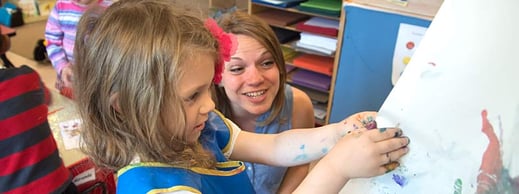
We asked our staff and certified CLASS observers about specific methods they have seen used to support quality interactions. So without further ado, here’s our list of 10 top effective teaching strategies.
-
“Pay close attention to each moment you are interacting with a child. What is that child telling you that they need from you? A hug? Help with a puzzle? Clear direction or redirection etc? Each cue from a child is an opportunity to respond in the way that leads to effective interactions across the Domains of CLASS.” —Mary-Margaret Gardiner
-
“To make learning come alive for children, teachers can plan questions that encourage children to connect concepts from the story to their world. Almost every book contains a central conflict or concept for children to consider in their own lives. Questions like, ‘How would you feel if this happened to you?,’ or ‘Have you ever been to a place like this? What was it like?.’ Those questions will help children connect concepts to real life." —Emily Doyle (From Teacher Tips: Making Real-World Connections Come Alive at Story Time)
-
"Pre-read the book you plan to use in your lesson. Plan open-ended questions you can ask before, during, and after to boost Concept Development." —Jenna Hynes
-
“Consider creating a ‘question of the week’ that you will ask to each child in your class in a one-on-one setting over the course of the week. Make time for these individualized back-and-forth conversations on the playground, during meal times, while waiting in line, during centers, etc. Simply ask the question and then show interest in the child's unique response by asking follow-up questions like, ‘Tell me more’ and ‘Why do you think that?’” —Mamie Morrow (From Teacher Tips: Asking Open-Ended Questions)
-
"Focus on one dimension or even indicator at a time. It’s much easier to break it down and target the improvement." —JJ Cohoon
-
“Start with clear behavioral expectations so that children know what to do, and be proactive. What activities and times of days are easier for you to be more flexible in your planning and scheduling? What about the more challenging times—how might you be flexible in small ways, such as giving children genuine choices, during these times?” —Kathryn Surchek (From Teacher Tips: Balancing Regard and Organization)
-
"Engage a child in a feedback loop about how to create something the child is interested in (cookies, an iPad, a pinata, e.g.). Before attempting to recreate the object, have the child list all the steps he/she needs to take to complete the project." —Carol Bolz (From Examples of Pairing Instructional Support and the Project Approach)
-
"Identify when children become disengaged with the subject matter. Think to yourself, 'Why is the child disinterested at this moment? Is this way over his head? Can I have him take a more active role in the subject?'" —(From Connecting with Pre-K Learners E-book)
-
"Be fully present, fully human, and intentional in our day-to-day interactions." —Marla Munter (From Teacher Impact: What Students Really Remember)
-
"Powerful Interactions approaches the question of how to improve interactions in three steps, and I think the first step—'Be Present'—is really difficult for teachers who have so many competing demands throughout the day." —Matthew Owens
What other effective strategies do you use to support children? Interested in learning about support in specific CLASS dimensions or indicators? Ask us below!

